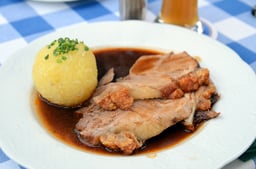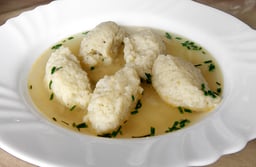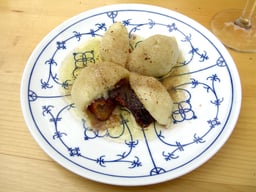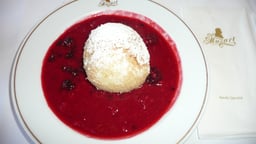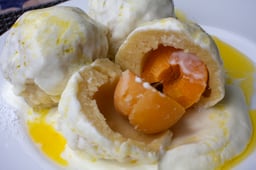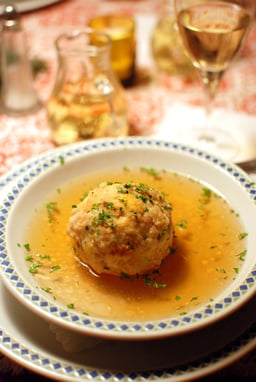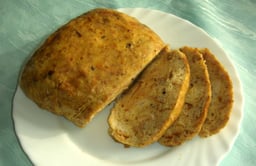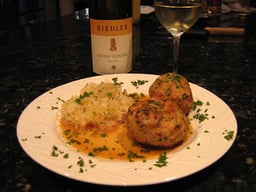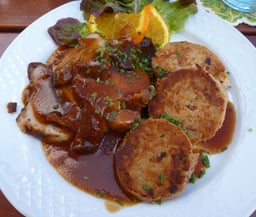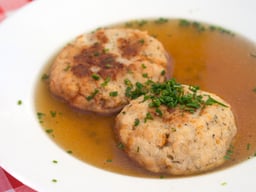Knödel

Knödel

| Alternative names | see below |
|---|---|
| Type | Dumpling |
| Region or state | Central Europe |
| Main ingredients | Potatoes or bread or flour |
| Variations | See list |
Knödel (pronounced [ˈknøːdl̩] (listen); sing. and pl.) or Klöße (pronounced [ˈkløːsə] (listen); sing. Kloß) are boiled dumplings[1] commonly found in Central European and East European cuisine. Central European countries in which their variant of Knödel is popular include Austria, Germany, Hungary, Poland, Serbia, Croatia, Slovenia, Slovakia, and the Czech Republic. They are also found in Scandinavian, Romanian, North-eastern Italian cuisine, Ukrainian and Belarusian cuisines. Usually made from flour, bread[1] or potatoes,[1] they are often served as a side dish, but can also be a dessert such as plum dumplings, or even meat balls in soup. Many varieties and variations exist.
| Alternative names | see below |
|---|---|
| Type | Dumpling |
| Region or state | Central Europe |
| Main ingredients | Potatoes or bread or flour |
| Variations | See list |
Etymology
The word Knödel is German and derives from the Latin word nōdus ("knot"). Through the Old High German chnodo and the Middle High German knode it finally changed to the modern expression.[2] Knödel in Hungary are called gombóc or knédli; in Slovenia, knedl(j)i or (less specifically) cmoki; in the Czech Republic, knedlíky (singular knedlík); in Slovakia, knedle (singular knedľa); in Luxembourg, Kniddel(en); in Bosnia, Croatia, Poland and Serbia, knedle; in Bukovina, cnigle; and, in Italy, canederli [kaˈnɛːderli]. In some regions of the United States, klub is used to refer specifically to potato dumplings. A similar dish is known in Sweden (kroppkakor or pitepalt) and in Norway (raspeball or komle), filled with salty meat; and in Canada (poutines râpées).
Varieties
Leberknödel are large dumplings made of ground liver and a batter made of bread soaked in milk and seasoned with nutmeg or other spices, boiled in beef stock and served as a soup.
Klöße are also large dumplings, steamed or boiled in hot water, made of dough from grated raw or mashed potatoes, eggs and flour. Similar semolina crack dumplings are made with semolina, egg and butter called Grießklößchen (Austrian Grießnockerl, Hungarian grízgaluska)[4]
Bread dumplings (Semmelknödel) are made with dried white bread, milk and egg yolks (are sometimes shaped like a loaf of bread, and boiled in a napkin, in which case they are known as napkin dumplings or Serviettenknödel). If bacon is added they are called Speckknödel.[1] Thüringer Klöße are made from raw or boiled potatoes, or a mixture of both, and are often filled with croutons or ham.
Plum dumplings (German: Zwetschgenknödel, Slavic: knedle), popular over Central Europe, are large sweet dumplings made with flour and potato batter, by wrapping the potato dough around whole plums (or apricots), boiled and rolled in hot buttered caramelized bread crumbs.[4][5]
Dumplings made with quark cheese (German: Topfenknödel, Hungarian: túrógombóc), traditionally topped with cinnamon sugar and served with apple sauce or with streusel.
In Brazil, German immigrants traditionally make Klöße with white rice, wheat flour and eggs, mixing them into a sturdy dough, shaping them in dumplings and boiling them.
Königsberger Klopse are not dumplings; they are made from ground meat and are related to Frikadeller.
Matzah balls could be considered Knödels made from matzah meal. The Yiddish word for Matzah balls, קניידל (kneydl), is cognate to Knödel. Matzah balls originated among Ashkenazi Jewish groups in Eastern or Central Europe.
Lithuanian Cepelinai.
Polish Knedle.
